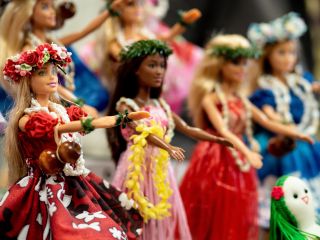Identity
What the Barbie Movie Can Teach Us About Human Development
Each stage of development presents us with a conflict that requires change.
Posted July 27, 2023 Reviewed by Jessica Schrader
Key points
- The pre-adolescent years challenge us to develop competencies to avoid feeling inferior.
- In adolescence, we carve out an identity in relationship to others.
- Each stage presents a crisis we need to resolve to move to the next stage of maturity.

This year’s must-see movie, Barbie, offers viewers an uplifting collective and thought-provoking experience. After the film, I saw three middle-aged couples with neon smiles donned head to toe in Barbie pinks and yellows, embracing one another with delight. Teens decked out in pink sequins and glittery platform heels waited in long lines to take selfies in the Barbie box. Senior citizens stood by smiling, infused with an energetic, youthful glow. I wondered what made this film so universally appealing to a diverse audience.
Barbie’s multi-layered script, written by Greta Gerwig and Noah Baumbach, allows the audience to find meaning beyond the sheer comedic fun of it all. Much has already been written about its feminist message that freedom from the patriarchy can liberate both men and women from living a stifling, inauthentic stereotype. Yet the movie also explores masculine and feminine identities from the perspective of childhood play toys. It’s as if the film asks, “Who am I beyond an object or toy for the amusement of society?”
Barbie and Ken’s journey from Barbie Land to the real world can teach us something valuable about human psychosocial development. The film shows how identity crisis serves as a right of passage in the quest for an authentic self.
Identity Foreclosure
Developmental psychologist James Marcia coined the term “identity foreclosure.” This is when we commit to an identity, perhaps one given to us in childhood before we’ve had a chance to explore anything else. It’s as if we wear a mask, acting as if we know ourselves when we’re unaware of other options. Children often take on their parent’s political identity as Democrat or Republican without knowing what those positions mean (Marcia, J. E. 2001).
The residents of Barbie Land have no understanding of the real world. Life consists of Dream House dance parties where they become the role of the costume they wear, or more accurately the garb put on them. Characters are labeled “weird Barbie,” “President Barbie,” or “conventional Barbie” based on appearance alone. This reflects the undeveloped preteen stage when we possess limited concepts for understanding ourselves and others.
Erik Erikson’s Stages of Psychosocial Development
Psychologist Erik Erikson studied human development through the lifespan. He saw that each stage of development presents us with a conflict. The conflict either defeats us or helps us to grow to the next level. Erikson saw the quest for identity as a “fundamental organizing principle which develops constantly throughout the lifespan.” He defined eight stages of human development, beginning at birth and ending in old age and death (Erikson, E. et al. 1998).
The Barbie movie opens briefly with little girls playing with baby dolls. Historically, girls’ play was relegated solely to the role of mother. Then along comes Barbie. A grown-up doll that allows girls to imagine themselves as astronauts, doctors, or even president.
The Barbie movie touches on a few of Erikson’s developmental stages. Stage four, Industry vs. Inferiority, corresponds to ages 6-11. This is when children develop competencies like swimming, playing an instrument, and learning in school. If we can acquire skills valued by others, we build self-confidence. If we fail to learn skills that others respect, we feel inferior.
When Ken, perfectly played by Ryan Gosling, enters the real world, he learns that “doing beach” is not a marketable skill. If you can’t swim, surf, or lifeguard, you won’t earn your peers' respect on the beach. Ken feels inferior. Like an elementary school boy, he sings, “I’m just Ken, and I’m enough, and I’m great at doing stuff,” as he strives to earn the respect of Barbie and his peers.
We’ve all been that kid, feeling inadequate, not knowing enough, and wanting love and respect. Erikson defines this stage as when a child’s social world expands beyond caregivers and immediate family. Social comparisons create internal conflicts where we ask: Who am I? What am I good at? How do I compare to others?
In Erikson’s model, each stage of development offers us an opportunity to acquire a virtue that supports our next development stage. The virtue of this fourth stage is competence. We want to feel “great at doing stuff.” If we don’t feel like we have some skills by the end of this stage, we suffer feelings of inferiority. It’s competency at something that gives us confidence.
Barbie’s happy Barbie Land existence begins to falter as she ponders death. Researchers found that children in this developmental stage begin to fully grasp death as a permanent, irreversible, inevitable event universal to all living things. Barbie’s existential crisis, in combination with her awareness of unwanted changes to her body (puberty?), drives her journey to the real world (Longbottom, S. et al. 2018).
Children in this stage grow from a richly imaginative world, where it can be difficult to differentiate between the real and imagined, toward a more mature understanding of the two worlds. The question remains, who am I in this bigger, grown-up, real world?
Barbie and Ken travel between Barbie Land and the Real World as they explore Erikson’s fifth stage of development: Identity vs. Role Confusion. During adolescence, ages 12-18, we struggle with the question, who am I as a social being? If we successfully grow through this stage, we cultivate the virtue of fidelity. Faithfulness to an authentic self with meaningful relationships. Our social relationships remain a vital, anchoring growth event during this stage.
As Barbie ventures out of Barbie Land or the imaginative world of the child self, she’s confronted with sexual harassment, misogyny, and a system aimed at literally keeping her in a box. Barbie, superbly played by actress and producer Margo Robbie, struggles with role confusion, unsure where or how she fits into the real world. Those stuck in this stage may move from job to job, or relationship to relationship, feeling ever disappointed with their place in life.
Like all adolescents, Barbie and Ken perform their masculinity and femininity with the costumes offered by social role models. Ken discovers patriarchy and brings his beer, cowboy hats, and man-cave saloons to Barbie Land. Performing what he thinks a man should be, he still can’t form an authentic relationship with Barbie. Intimacy requires closeness, honesty, and love. If we play a role, our relationships will remain superficial and empty.
When Barbie sees an old woman sitting beside her on a bench, she exclaims, “You’re so beautiful!” The woman replies with a grin, “I know.” The older woman evokes the final stage of development, Integrity vs. Despair. When we review our life with acceptance and a sense of fulfillment, we hold ourselves with confidence and depth. Barbie learns that the wisdom of a well-lived life packs more power and wisdom than performative beauty and fashion.
She later encounters the ghost of Ruth Handler, inventor of Barbie and co-founder of Mattel. As she asks the wise old woman her urgent questions, Ruth says, “Humans only have one ending. Ideas last forever.” I’m reminded of a quote by Oliver Wendell Holmes, “Man’s mind, once stretched by a new idea, never regains its original dimensions.”
As Barbie wrestles with the bittersweet nature of life in the real world, she asks her mother/creator, Ruth, if she can be a real human. “You don’t need my permission,” Ruth tells Barbie. “I can’t control you any more than I could control my own daughter. I named you after her: Barbara. And I always hoped for you like I hoped for her. We mothers stand still, so our daughters can look back to see how far they’ve come.”
Barbie and Ruth take us to that necessary part of human development, leaving home and developing an identity independent of our parents. Ruth inhabits Eriksons’ seventh stage of development, Generativity vs. Stagnation, the middle-aged years of working, raising, and launching children. The screenwriters capture that point of parental pain when we must let go of the children we’ve created so they can become themselves.
The film’s final moments close out with Billie Eilish singing an anthem of human psychosocial development, appropriately titled, “What was I made for?” It captures the anguish we all feel in our struggle for purpose, identity, significance, and meaning.
Our whole life is an unfolding, a becoming, a rediscovering, a breaking down, and a rebuilding of our many selves. It helps to lean into compassion within the struggle. At any given point, you are enough. Or, as Ken would say, you are Kenough.
References
Erikson, E. & Erikson, J., 1998, The Life Cycle Completed, W.W. Norton & Co., New York, NY.
Longbottom S, Slaughter V. Sources of children's knowledge about death and dying. Philos Trans R Soc Lond B Biol Sci. 2018 Sep 5;373(1754):20170267. doi: 10.1098/rstb.2017.0267. PMID: 30012734; PMCID: PMC6053990.
J.E. Marcia, Identity in Childhood and Adolescence, Editor(s): Neil J. Smelser, Paul B. Baltes,
International Encyclopedia of the Social & Behavioral Sciences, Pergamon, 2001, Pages 7159-7163




